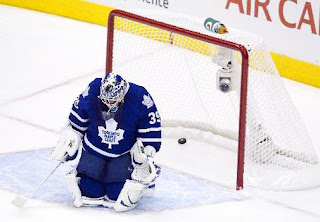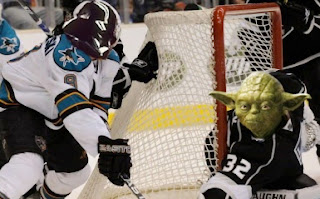Doug, a men's league goalie in his forties that I work with occasionally stopped me in the middle of our last lesson and asked me a very basic question, "when should I be in my stance?"
An easy answer to this question is that anytime you might take a shot, you should be ready in your stance. This answer might suffice if things didn't change so quickly throughout the course of a hockey game. I have developed a very basic system to ensure you are always at the appropriate level of preparation.
When the puck is at the other end of the ice, beyond the red line, I suggest you relax comfortably, but still follow the play with your eyes, watching for possible outlet passes, and ready to alert your D of any cherry pickers sneaking past them. Once the puck crosses the red line to your half of the ice, it's time to get into your goalie stance and prepare for a shot. It doesn't matter if your team has the puck, or the other team, if the puck is in your half of the ice, it is always best to be in your stance with your stick on the ice, knees bent, and hands ready. It is not yet necessary to come out on an angle yet, because you should be able to stop any shot from beyond the blue line without an issue, no matter how deep in your net you are.
Once the puck crosses the blue line, it is time to DRIVE out on your angle. I see so many goaltenders C-Cut, skate, or telescope out to meet the play, and this is simply too slow. Use a single T-Push, and DRIVE straight out towards the play as it enters the zone. If it is an average speed break, like a 3 on 2, for example, you do not need to come out past the top of your crease. If it is a breakaway, I recommend taking two additional C-Cuts out past the top of your crease. This additional distance gives you time to match the speed of the shooter, a key to stopping a breakaway.
Once the puck is in your zone, there are really only two skating maneuvers you will ever need to use to follow it effectively: T-Pushes and Shuffles. The T-Push is used to follow a pass, or to come off your post to follow a skater. The key to a good T-Push is leading with your hands, driving hard with your pushing leg (power leg) and stopping quickly with your other skate. If the right leg pushes, the left skate stops us and vice versa. No exceptions to that rule!
The shuffle is used to follow a player skating with the puck. When we shuffle, every part of our body stays square to the puck, from our pads, to our shoulders, to our hands. The best way to think about a shuffle is a small, quick adjustment to stay square to the play. Long shuffles lead to big holes between the pads, and slow reaction times. By keeping your shuffles short and crisp, we always have both feet on the ice, and can easily drive in any direction. When shuffling or T-Pushing it is very important that your head and shoulders DO NOT bounce up and down, but stay very still and even. Your knees stay bent, your hands stay the same distance apart, and your stance stays in tact. You simply move your stance efficiently.
Now let me save you a goal or two in the future: Often once our D has taken control of the puck, we relax and come out of our stance, or stay on our goal line as the D starts the break out. This lackadaisical attitude leads to countless goals when our D is dispossessed by a forechecker, or makes an ill advised pass across the front of the net. Now the other team has the puck, and we are standing straight up, with no angle! No matter which team has the puck, it is critical to follow it using T-Pushes and Shuffles WHENEVER it is inside our blue line.
In summary: If the puck is at the other end of the ice, relax and watch it. When it crosses the red line, take your stance. As it crosses the blue line, DRIVE out on your angle (2 extra C-Cuts for a breakaway). Once the puck is in your zone, use T-Pushes and Shuffles, and always stay in your stance. Simple, right?
So many times I see young and old goalies alike "cruising" around their crease without using T-Pushes and Shuffles, caught off guard by quick breaks or turnovers, and rarely square to the shot. By using these techniques every single game, not only will you look more focused and professional, but you are always prepared for a shot, and that is the first key to making a save!
An easy answer to this question is that anytime you might take a shot, you should be ready in your stance. This answer might suffice if things didn't change so quickly throughout the course of a hockey game. I have developed a very basic system to ensure you are always at the appropriate level of preparation.
When the puck is at the other end of the ice, beyond the red line, I suggest you relax comfortably, but still follow the play with your eyes, watching for possible outlet passes, and ready to alert your D of any cherry pickers sneaking past them. Once the puck crosses the red line to your half of the ice, it's time to get into your goalie stance and prepare for a shot. It doesn't matter if your team has the puck, or the other team, if the puck is in your half of the ice, it is always best to be in your stance with your stick on the ice, knees bent, and hands ready. It is not yet necessary to come out on an angle yet, because you should be able to stop any shot from beyond the blue line without an issue, no matter how deep in your net you are.
Once the puck crosses the blue line, it is time to DRIVE out on your angle. I see so many goaltenders C-Cut, skate, or telescope out to meet the play, and this is simply too slow. Use a single T-Push, and DRIVE straight out towards the play as it enters the zone. If it is an average speed break, like a 3 on 2, for example, you do not need to come out past the top of your crease. If it is a breakaway, I recommend taking two additional C-Cuts out past the top of your crease. This additional distance gives you time to match the speed of the shooter, a key to stopping a breakaway.
Once the puck is in your zone, there are really only two skating maneuvers you will ever need to use to follow it effectively: T-Pushes and Shuffles. The T-Push is used to follow a pass, or to come off your post to follow a skater. The key to a good T-Push is leading with your hands, driving hard with your pushing leg (power leg) and stopping quickly with your other skate. If the right leg pushes, the left skate stops us and vice versa. No exceptions to that rule!
This goaltender is demonstrating how to lead with your hands on a T-Push.
The shuffle is used to follow a player skating with the puck. When we shuffle, every part of our body stays square to the puck, from our pads, to our shoulders, to our hands. The best way to think about a shuffle is a small, quick adjustment to stay square to the play. Long shuffles lead to big holes between the pads, and slow reaction times. By keeping your shuffles short and crisp, we always have both feet on the ice, and can easily drive in any direction. When shuffling or T-Pushing it is very important that your head and shoulders DO NOT bounce up and down, but stay very still and even. Your knees stay bent, your hands stay the same distance apart, and your stance stays in tact. You simply move your stance efficiently.
In this video, Ronan Mobley shows proper shuffling technique.
Now let me save you a goal or two in the future: Often once our D has taken control of the puck, we relax and come out of our stance, or stay on our goal line as the D starts the break out. This lackadaisical attitude leads to countless goals when our D is dispossessed by a forechecker, or makes an ill advised pass across the front of the net. Now the other team has the puck, and we are standing straight up, with no angle! No matter which team has the puck, it is critical to follow it using T-Pushes and Shuffles WHENEVER it is inside our blue line.
In summary: If the puck is at the other end of the ice, relax and watch it. When it crosses the red line, take your stance. As it crosses the blue line, DRIVE out on your angle (2 extra C-Cuts for a breakaway). Once the puck is in your zone, use T-Pushes and Shuffles, and always stay in your stance. Simple, right?
So many times I see young and old goalies alike "cruising" around their crease without using T-Pushes and Shuffles, caught off guard by quick breaks or turnovers, and rarely square to the shot. By using these techniques every single game, not only will you look more focused and professional, but you are always prepared for a shot, and that is the first key to making a save!





















